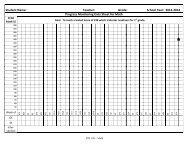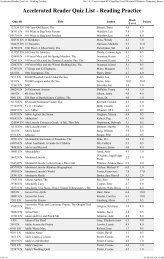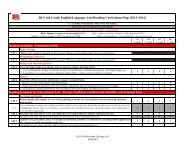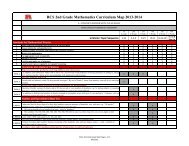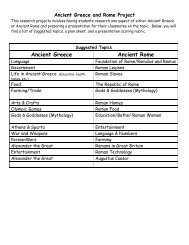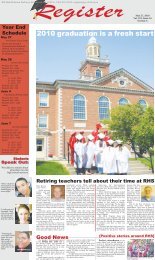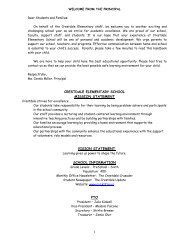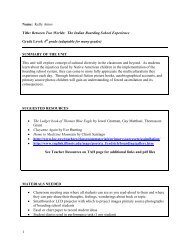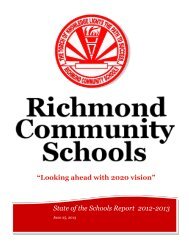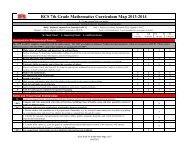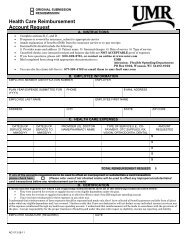2013-2014 ELA Grade 1.pdf
2013-2014 ELA Grade 1.pdf
2013-2014 ELA Grade 1.pdf
Create successful ePaper yourself
Turn your PDF publications into a flip-book with our unique Google optimized e-Paper software.
1.RF.1<br />
1.RF.2<br />
1.RF.3<br />
RCS 1st <strong>Grade</strong> English/Language Arts/Reading Curriculum Map (<strong>2013</strong>-<strong>2014</strong>)<br />
Reading Standards: Foundational Skills<br />
X = COVERED IN READING STREET THIS SIX WEEKS<br />
TESTED ON ACUITY DIAGNOSTIC ASSESSMENT<br />
Print Concepts<br />
Demonstrate understanding of the organization and basic features of print.<br />
a. Recognize the distinguishing features of a sentence (e.g., first word, capitalization, ending punctuation). X X X<br />
Phonological Awareness<br />
Demonstrate understanding of spoken words, syllables, and sounds (phonemes).<br />
a. Distinguish long from short vowel sounds in spoken single-syllable words. X X X<br />
b. Orally produce single-syllable words by blending sounds (phonemes), including consonant blends. X X X X X X<br />
c. Isolate and pronounce initial, medial vowel, and final sounds (phonemes) in spoken single-syllable words. X X X X X<br />
d. Segment spoken single-syllable words into their complete sequence of individual sounds (phonemes). X X X X X X<br />
Phonics and Word Recognition<br />
Know and apply grade-level phonics and word analysis skills in decoding words.<br />
a. Know the spelling-sound correspondences for common consonant digraphs. X X X X X<br />
b. Decode regularly spelled one-syllable words. X X X X X X<br />
c. Know final -e and common vowel team conventions for representing long vowel sounds. X X X X<br />
1st<br />
6 weeks<br />
2nd<br />
6 Weeks<br />
3rd<br />
6 Weeks<br />
4th<br />
6 Weeks<br />
5th<br />
6 Weeks<br />
d. Use knowledge that every syllable must have a vowel sound to determine the number of syllables in a printed word. X X X<br />
e. Decode two-syllable words following basic patterns by breaking the words into syllables. X X<br />
f. Read words with inflectional endings. X X X X<br />
g. Recognize and read grade-appropriate irregularly spelled words X X X X X X<br />
Fluency<br />
1.RF.4 Read with sufficient accuracy and fluency to support comprehension.<br />
a. Read on-level text with purpose and understanding. X X X X X X<br />
b. Read on-level text orally with accuracy, appropriate rate, and expression on successive readings. X X X X X X<br />
c. Use context to confirm or self-correct word recognition and understanding, rereading as necessary. X X X X X X<br />
Reading Standards for Informational Text: Literary Nonfiction and Historical, Scientific, Technical Texts<br />
Key Ideas and Details<br />
1.RI.1 With prompting and support, ask and answer questions about key details in a text. X X X X X<br />
1.RI.2 With prompting and support, identify the main topic and retell key details of a text. X X X X X<br />
1.RI.3 Describe the connection between two individuals, events, ideas, or pieces of information in a text. X X X X X<br />
6th<br />
6 Weeks<br />
<strong>2013</strong>-<strong>2014</strong> 1st <strong>Grade</strong> <strong>ELA</strong> Page 1 of 4<br />
5/28/<strong>2013</strong>
1.RI.4 Ask and answer questions to help determine or clarify the meaning of words and phrases in a text. X X X X<br />
1.RI.5<br />
Know and use various text features (e.g., headings, tables of contents, glossaries, electronic menus, icons) to locate key facts<br />
or information in a text.<br />
X X X X X X<br />
1.RI.6 Distinguish between information provided by pictures or other illustrations and information provided by the words in a text. X X X X X X<br />
Integration of Knowledge and Ideas<br />
1.RI.7 Use the illustrations and details in a text to describe its key ideas. X X X X X X<br />
1.RI.8 Identify the reasons an author gives to support points in a text. X X X X X<br />
1.RI.9<br />
Identify basic similarities in and differences between two texts on the same topic (e.g., in illustrations, descriptions, or<br />
procedures).<br />
Range of Reading and Level of Text Complexity<br />
1.RI.10 With prompting and support, read informational texts appropriately complex for grade 1. X X X X X<br />
1.RL.1 Ask and answer questions about key details in a text. X X X X X X<br />
1.RL.2 Retell stories, including key details, and demonstrate understanding of their central message or lesson. X X X X X X<br />
1.RL.3 Describe characters, settings, and major events in a story, using key details. X X X X X X<br />
Craft and Structure<br />
1.RL.4 Identify words and phrases in stories or poems that suggest feelings or appeal to the senses. X X X X<br />
1.RL.5<br />
Explain major differences between books that tell stories and books that give information, drawing on a wide reading of a<br />
range of texts.<br />
X X X X X X<br />
1.RL.6 Identify who is telling the story at various points in a text. X X X X<br />
Integration of Knowledge and Ideas<br />
1.RL.7 Use illustrations and details in a story to describe its characters, setting, or events. X X X X X X<br />
1.RL.8 (This College and Career Readiness Standard does not have a literature component)<br />
1.RL.9 Compare and contrast the adventures and experiences of characters in stories. X X X X X<br />
Range of Reading and Level of Text Complexity<br />
1.RL.10 Actively engage in group reading activities with purpose and understanding. X X X X X X<br />
Writing Standards<br />
1.W.1<br />
1.W.2<br />
1.W.3<br />
Craft and Structure<br />
Reading Standards for Literature: Stories, Novels, Dramas, and Poetry<br />
Key Ideas and Details<br />
Text Types and Purposes<br />
Write opinion pieces in which they introduce the topic or name the book they are writing about, state an opinion, supply a<br />
reason for the opinion, and provide some sense of closure.<br />
Use a combination of drawing, dictating, and writing to compose informative/explanatory texts in which they name what they<br />
are writing about and supply some information about the topic.<br />
Write narratives in which they recount two or more appropriately sequenced events, include some details regarding what<br />
happened, use temporal words to signal event order, and provide some sense of closure.<br />
X X X X X<br />
X X X X<br />
X X X X X<br />
<strong>2013</strong>-<strong>2014</strong> 1st <strong>Grade</strong> <strong>ELA</strong> Page 2 of 4<br />
5/28/<strong>2013</strong>
1.W.4 (Begins in grade 3)<br />
1.W.5<br />
With guidance and support from adults, respond to questions and suggestions from peers and add details to strengthen writing<br />
as needed.<br />
1.W.6<br />
With guidance and support from adults, explore a variety of digital tools to produce and publish writing, including<br />
collaboration with peers.<br />
Research to Build and Present Knowledge<br />
1.W.7<br />
Participate in shared research and writing projects (e.g., explore a number of "how-to" books on a given topic and use them to<br />
write a sequence of instructions).<br />
1.W.8<br />
With guidance and support from adults, recall information from experiences or gather information from provided sources to<br />
answer a question.<br />
1.W.9 (Begins in grade 4)<br />
Range of Writing<br />
1.W.10 (Begins in grade 3)<br />
1.L.1<br />
1.L.2<br />
Production and Distribution of Writing<br />
Language Standards<br />
X X X X X X<br />
X<br />
X<br />
X X X X<br />
X X X X X<br />
Conventions of Standard English<br />
Demonstrate command of the conventions of Standard English grammar and usage when writing or speaking.<br />
a. Print all uppercase and lowercase letters. X X X X X X<br />
b. Use common, proper, and possessive nouns. X X X<br />
c. Use singular and plural nouns with matching verbs in basic sentences (e.g., He hops; We hop). X X X X<br />
d. Use personal, possessive, and indefinite pronouns (e.g., I, me, my; they, them, their; anyone, everything). X X X X<br />
e. Use verbs to convey a sense of past, present, and future (e.g., Yesterday I walked home; Today I walk home; Tomorrow I<br />
will walk home).<br />
X<br />
X<br />
f. Use frequently occurring adjectives. X X X<br />
g. Use frequently occurring conjunctions (e.g., and, but, or, so, because). X X X X X<br />
h. Use determiners (e.g., articles, demonstratives). X<br />
i. Use frequently occurring prepositions (e.g., during, beyond, toward).<br />
j. Produce and expand complete simple and compound declarative, interrogative, imperative, and exclamatory sentences in<br />
response to prompts.<br />
X X X X X X<br />
Demonstrate command of the conventions of Standard English capitalization, punctuation, and spelling when writing.<br />
a. Capitalize dates and names of people. X<br />
b. Use end punctuation for sentences. X X<br />
c. Use commas in dates and to separate single words in a series. X<br />
d. Use conventional spelling for words with common spelling pattterns and for frequently occurring irregular words. X X X X X X<br />
e. Spell untaught words phonetically, drawing on phonemic awareness and spelling conventions. X X X X X<br />
Knowledge of Language<br />
1.L.3 (Begins in grade 2)<br />
<strong>2013</strong>-<strong>2014</strong> 1st <strong>Grade</strong> <strong>ELA</strong> Page 3 of 4<br />
5/28/<strong>2013</strong>
1.L.4<br />
1.L.5<br />
1.L.6<br />
Vocabulary Acquisition and Use<br />
Determine or clarify the meaning of unknown and multiple-meaning words and phrases based on grade 1 reading and content, choosing flexibly from an array of strategies.<br />
a. Use sentence-level context as a clue to the meaning of a word or phrase. X X X<br />
b. Use frequently occurring affixes as a clue to the meaning of a word. X X X X<br />
c. Identify frequently occurring root words (e.g., look) and their inflectional forms (e.g., looks, looked, looking). X X X<br />
With guidance and support from adults, explore word relationships and nuances in word meanings.<br />
a. Sort words into categories (e.g., colors, clothing) to gain a sense of the concepts the categories represent. X X X X X<br />
b. Define words by category and by one or more key attributes (e.g., a duck is a bird that swims; a tiger is a large cat with<br />
stripes).<br />
X X X<br />
c. Identify real-life connections between words and their use (e.g., note places at home that are cozy). X X X X X X<br />
d. Distinguish shades of meaning among verbs differing in manner (e.g., look, peek, glance, stare, glare, scowl) and<br />
adjectives differing in intensity (e.g., large, gigantic) by defining or choosing them or by acting out the meanings.<br />
X X X X<br />
Use words and phrases acquired through conversations, reading and being read to, and responding to texts, including using<br />
frequently occurring conjunctions to signal simple relationships (e.g., I named my hamster Nibblet because she nibbles too<br />
much because she likes that).<br />
Speaking and Listening Standards<br />
X X X X X X<br />
Comprehension and Collaboration<br />
1.SL.1 Participate in collaborative conversations with diverse partners about grade 1 topics and texts with peers and adults in small and larger groups.<br />
a. Follow agreed-upon rules for discussions (e.g., listening to others with care, speaking one at a time about the topics and<br />
texts under discussion).<br />
X X X X X X<br />
b. Build on others' talk in conversations by responding to the comments of others through multiple exchanges. X X X X X<br />
c. Ask questions to clear up any confusion about the topics and texts under discussion. X X X X X<br />
1.SL.2 Ask and answer questions about key details in a text read aloud or information presented orally or through other media. X X X X X X<br />
1.SL3<br />
Ask and answer questions about what a speaker says in order to gather additional information or clarify something that is not<br />
understood.<br />
X X X X X X<br />
Presentation of Knowledge and Ideas<br />
1.SL.4 Describe people, places, things, and eventswith relevant details, expressing ideas and feelings clearly. X X X X X X<br />
1.SL.5 Add drawings or other visual displays to descriptions when appropriate to clarify ideas, thoughts, and feelings. X X X<br />
1.SL.6 Produce complete sentences when appropriate to task and situation. X X X X X<br />
<strong>2013</strong>-<strong>2014</strong> 1st <strong>Grade</strong> <strong>ELA</strong> Page 4 of 4<br />
5/28/<strong>2013</strong>



